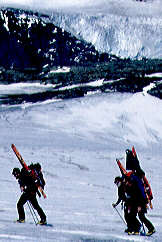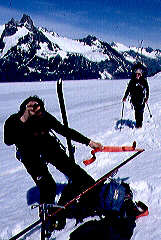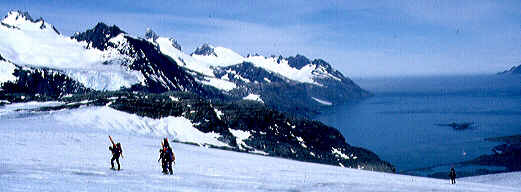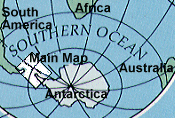
![]()
.
.
.
.
.
.
.
.
.
.

.
.
.

![]()

[
Logbook Index ]

Log
Entry for 9 February 1997
Click map for detailed chart
Position 1200 King Haakon Bay 54 09S 37 16W.

The
South Aris team depart King Haakon Bay
on the South Georgia
traverse.
|
"The first time I killed one (an albatross chick)," said Worsely, "I felt like a murderer, the second time a little less bad, and after that I just thought what a fine meal they would make, and what a glorious feed the first had been." On May 19th 1916, after several days preparation thawing out frost bitten feet, mending clothes and equipment and feeding up on seal, penguin and albatross chicks; Shackleton, Worsely and Crean left their 'Peggoty Camp' at the head of King Haakon Bay for the traverse of South Georgia to the whaling station at Stromness. It was 0200 and they awoke to a shining moon in an otherwise cloudless and windless sky. Ahead of them lay unexplored mountainous terrain - it was once again do or die, not only for them but for the men left behind on Elephant Island and here at Peggoty. McCarthy and Vincent were wasted and could go no further. The area described by Shackleton and Worsely in their books has changed greatly in character since 1916. The site of Peggoty Camp was obvious behind the Vincent Islands near a bluff along the beach. There was no trace of their camp in the upturned James Caird, nor of what Worsely described as "A marvellous pile of drift-wood, covering half an acre, and piled from four to eight feet high in places. This was a graveyard of ships - woeful flotsam and jetsam - sport of the sea . . . Most of it had drifted a thousand miles from Cape Horn, some of it two thousand miles or more." Also changed is the glacier which lay to their immediate east. They could barely pass around the snout at low water, but today it has receded well inland leaving a level moraine. It is now a a pleasant stroll to the rising slope towards 'Shackleton's Gap.' The South-Aris team, had barely enough time to catch their breath before their departure. February 9th began auspiciously - clear weather, sunny and windless. We called Bob Rice's weather window to get a 48 hour prognosis. The news was not entirely in their favor - good today but moderate to heavy westerlies forecasted for the next six days. On the other hand, they could make a good start and cover a lot of ground today so they went for it. By 0900 they were on the beach, rucsacs shouldered with food and fuel for four days, glacier travel equipment and ski mountaineering gear. Elena, John and I with Mick filming, followed them up the 'dry glacier' of 20 degrees, crunching along with our crampons admiring the view> Pelagic with Patrick and Jarlath remaining on board quickly receded to a speck in the sound. On a 'dry glacier' a rope is not needed as the crevasses are all obvious. When snow covered, falling into a hidden crevasse becomes a hazard, so a rope is then a necessity for ultimate safety. Just below Shackletons Gap, which is the high point, or col, between Possession Bay to the east and King Haakon to the west, we left Mike Barry, Frank Nugent, Jamie Young and Paddy Barry to their own devices. Snow cover was to be negotiated so they changed crampons for skis and roped up. Not following Shackleton's exact route, they cut a corner avoiding the descent into Possession Bay and headed straight for the ridge above Antarctic Bay. Route finding was a dream in the clear, windless conditions. Elena and I climbed higher to the summit of a nunatak, a rocky shoulder in the middle of the Gap. At 1,800 feet, we had a clear view down both into Possession and King Haakon. Pelagic was too small to be seen. The traverse party were also visible to the east, four specks on a field of white - they were well on their way. We had a leisurely lunch and then wandered back down to Pelagic. We would try to get back to Bird Island before dark, spend the night there, then leave for Stromness the next morning. Given the conditions we expected them to do the 32 kilometer trek before we could negotiate the 85 sea miles! In 1997 we are all very organized, armed with satellite photos, maps and knowledge from previous expeditions. We are also well rested and fresh instead of having spent 6 debilitating months on the ice before undertaking the voyage in an open boat. In the winter of 1916, as Shackleton later pointed out, "No man had ever penetrated a mile from the coast of South Georgia at any point, and the whalers I knew regarded the country as inaccessible.. . . the bright moonlight showed us that the interior was broken tremendously. High peaks, impassable cliffs, steep snow slopes, and sharply descending glaciers were prominent features in all directions." Enter "the fourth man." Skip Novak |

